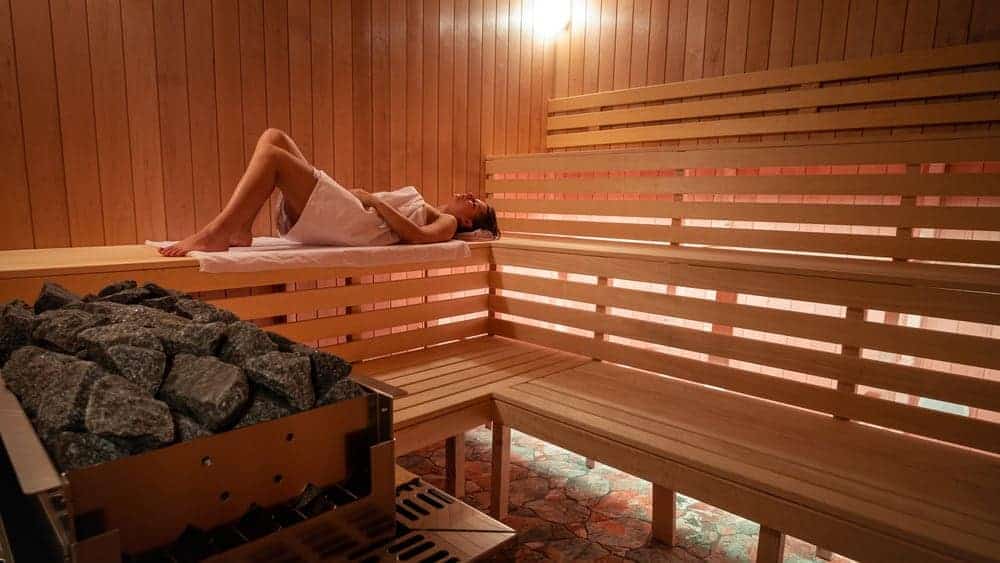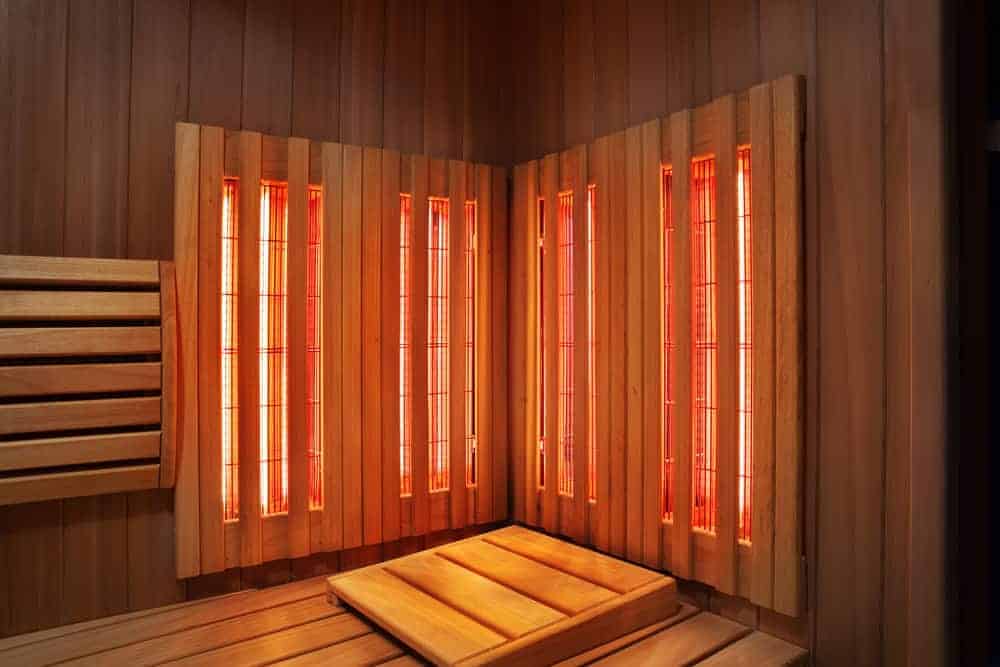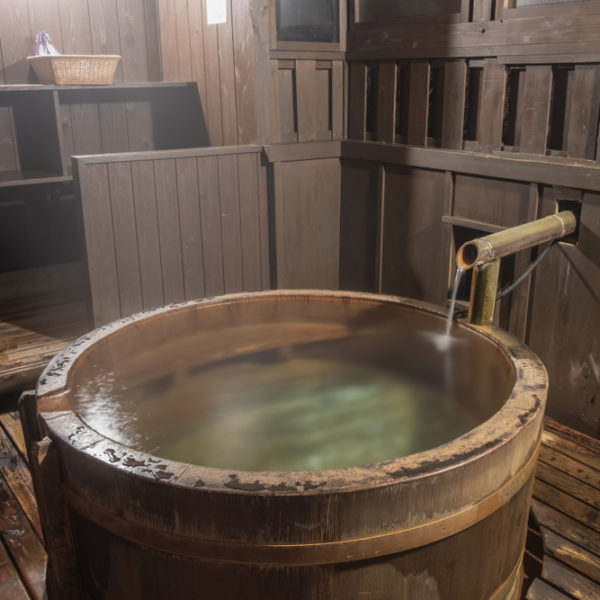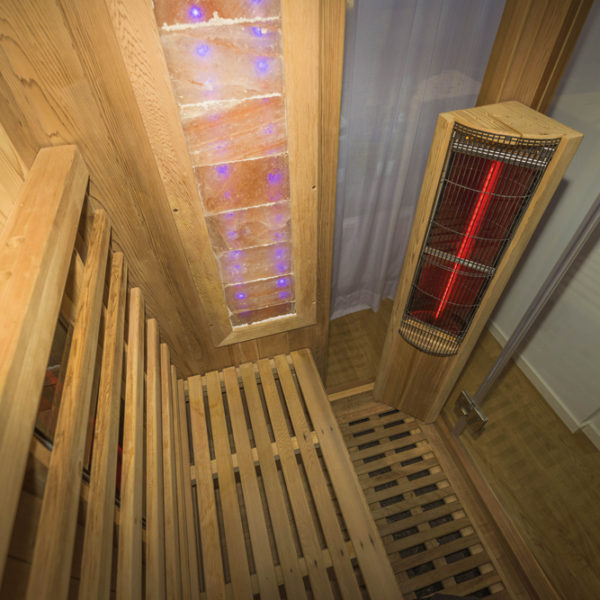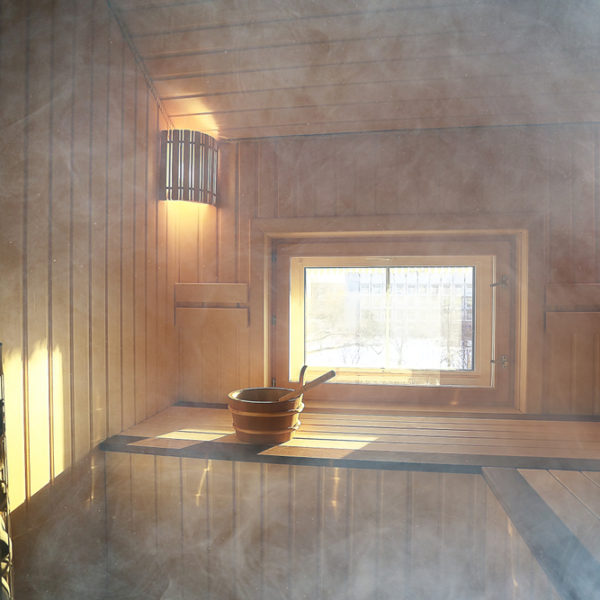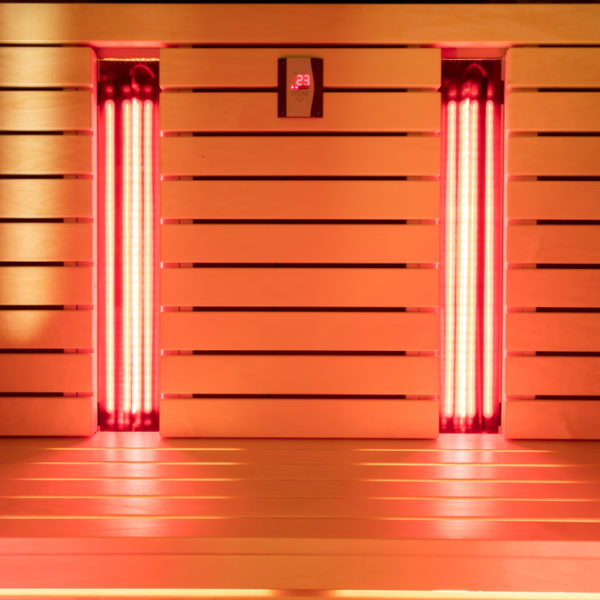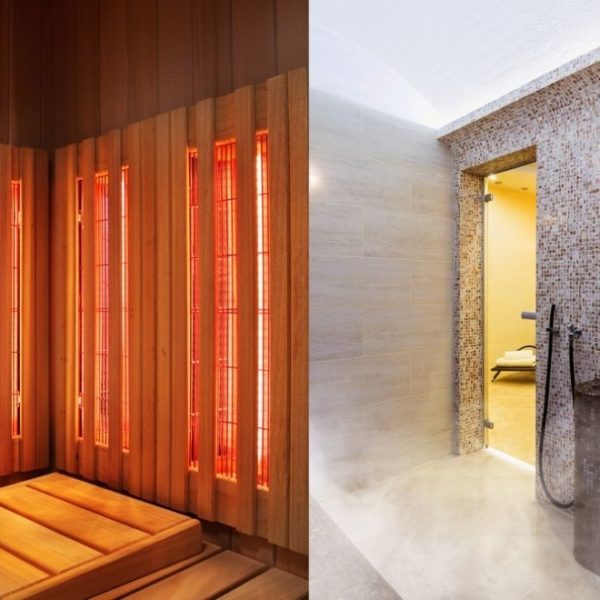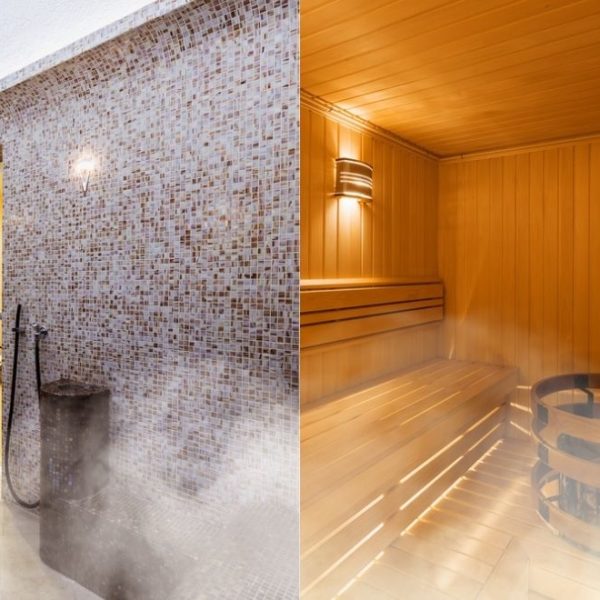Saunas are an excellent way to relax, and they also have many proven – as well as suspected – health benefits.
However, there’s more than one type of sauna, and the advantages and disadvantages are not quite the same from one to the next. So to help you understand the differences, here we discuss the question of dry vs wet sauna to give you all the info you need.
If you want a preview of some of the stuff we’re going to be talking about, you can also check out this video before reading on.
What’s in a name?
Before we dive in, let’s talk about terminology – because not everyone agrees on what different types of saunas should be called.
For us, a “dry sauna” is a traditional Finnish-style sauna while a “wet sauna” is what’s sometimes also known as a “steam room”. Then there’s also the infrared sauna, another kind of dry sauna – which we’ll mention again later.
However, some people distinguish between a traditional sauna with and without steam, referring to these as “dry” and “wet” saunas respectively. For these people, a steam room is something else entirely – and an infrared sauna is something else again.
In the end, it doesn’t matter what you call them – what’s important is what they do and the benefits that can be derived from them.
So for the rest of this post, we’ll be sticking to our definitions – but be aware that some people might define their saunas differently.
What’s a dry sauna?
The modern dry sauna is derived from the saunas that were built in Finland hundreds of years ago and is based on heating a small room to temperatures high enough to induce copious sweating.
The most traditional version uses stones heated over a wood fire. Water is usually then thrown over the stones to create steam, which increases the ambient temperature even further.
However, nowadays, electric stoves or other heating methods can also be used instead of the more traditional hot stones.
Dry saunas incorporate vents to allow steam to escape. This means humidity is usually in the 5-30% range, so although they are sometimes called “dry” saunas, the air inside still retains a certain amount of moisture.
The walls are usually made of wood, with pine, cedar and spruce being common choices. These walls absorb moisture, also helping to reduce the humidity inside the sauna.
Temperatures in traditional saunas can reach around 160-200°F, and inside, you will usually find seating at different levels – the upper row of seating has a higher temperature while on the lower row, temperatures are slightly less intense.
What are the benefits of a dry sauna?
Finnish saunas originally developed as a way of keeping warm in winter, but over time, sitting in a hot sauna became an enjoyable social activity. Saunas are now known to provide a range of additional health benefits, and here are some of the most important:
1. Improved circulation
Sitting inside a hot sauna causes the heart rate to increase, which, in turn, increases circulation. This provides many of the same benefits to your heart as a gentle cardio workout, although not for your body – you’ll need to do some actual exercise for that!
Saunas can also help improve blood flow to arms, hands, legs and feet.
2. Lower blood pressure
Regular sauna use has been shown to lower blood pressure in the long term – although when you first start using a sauna, your blood pressure might go up slightly as your body adjusts.
3. Lower risk of heart attack and other heart-related conditions
Studies have found a correlation between regular sauna use and lower instances of heart-related issues such as sudden cardiac arrest, coronary heart disease and cardiovascular disease. Which basically means using a sauna can help you live longer!
4. Relief from rheumatic diseases
One piece of research investigating the health benefits of sauna use found that patients suffering from conditions such as rheumatoid arthritis and ankylosing spondylitis reported a reduction in pain after regular sauna treatments.
5. Enhanced sporting performance and recovery
Saunas are commonly used by athletes to speed up recovery after training or competition since they can loosen up tense muscles, making them more pliable and elastic.
6. Relief from aches, pains
Although not necessarily backed up by scientific studies, most regular users will tell you that a session in the sauna is a great treatment for all kinds of general aches and pains.
7. Improvements to skin and skin “glow”
The heat inside a sauna that causes you to sweat also opens up your pores, which cleanses your skin while increasing blood flow beneath the skin. This is why so many people report a healthy skin “glow” after visiting a sauna.
There is also some evidence that saunas are a useful treatment for conditions like psoriasis as well as dry skin in general.
8. Improvements to respiratory conditions
Saunas can be beneficial for people suffering from respiratory conditions such as asthma, and regular visits can help reduce wheezing.
9. Stress relief and improved mood
Aside from all the physical benefits, one of the much-vaunted positives of sauna use is the stress relief they provide, which, in many ways, is just as important.
Sitting in a sauna is relaxing and enjoyable, and depending on where you go and who you go with, there may also be a social aspect too.
One small study in Finland noted reduced incidences of psychotic disorders in males who regularly visited saunas, suggesting some advantages to mental health.
However, even without studies like this, we all know how important it is to take time out and relax, and sitting in a sauna is the perfect way to do it – so it’s no wonder that regular sauna users enjoy the experience, and that people just tend to feel happier after sitting in a sauna.
10. Immune system boost
There are some suggestions that saunas can help boost our immune systems, although this could simply be down to the benefits of stress reduction, which is a major factor in keeping our immune systems in good shape.
For example, one small study in Austria showed that sauna users were less susceptible to catching the common cold – although more work is required to confirm these results and the reasons for the findings.
11. Reduced instance of dementia
There is even evidence that regular sauna use may reduce the risk of dementia. However, more work is required to confirm this as well as to establish why it might be true.
What’s a wet sauna?
So as you can see, sitting in a traditional “dry” sauna has a wide range of health benefits, but what about “wet” saunas? We’ll come to this in just a moment, but before we get there, let’s talk about what a wet sauna is and how it differs from a dry sauna.
A wet sauna – or steam room – is heated by pumping steam into it from an external steam generator. The room is nearly airtight to prevent the steam from escaping, and there is no vent, which results in a humidity level that approaches 100%.
Steam rooms are not as hot as traditional saunas, usually only reaching around 100-120°F, but due to the high humidity, your sweat is less effective at cooling your body, so they may feel hotter than a dry sauna.
Due to the high humidity – and also to help maintain it – steam rooms are usually made of materials such as ceramic, glass or plastic.
Like traditional saunas, they often also have graded seating, with the higher part being hotter and the lower part being slightly cooler.
What are the benefits of a wet sauna?
Since steam rooms and dry saunas both raise your body temperature and make you sweat, steam rooms offer all the same benefits as dry saunas.
However, due to the extra steam and humidity, steam rooms have a few extra advantages over traditional saunas. Here are the main ones:
1. Especially good for respiratory conditions
The extra steam and humidity make steam rooms particularly good for people who suffer from conditions like asthma or allergies.
Furthermore, medication for conditions like these can dry out your respiratory tract somewhat, so steam rooms can help by moisturizing your airways and opening your lungs.
Finally, if you are suffering from a cough, congestion or excess mucous, a steam room can provide at least some temporary relief by helping to clear out your passages.
2. Skin conditions
Although dry saunas can help with dry skin, wet saunas are even better. They can moisten your skin, leaving it looking and feeling better after a treatment.
What about infrared saunas?
And now a quick word about infrared saunas. These are a kind of dry sauna – in fact, a totally dry sauna – that uses infrared electromagnetic radiation to heat your body.
This works by heating your skin directly rather than heating the air around you, so the air inside the sauna has practically no humidity at all.
The supposed benefits come from the fact that infrared rays can penetrate your body, providing a deeper, more thorough treatment.
Since the temperatures are much lower, usually in the 120-140°F range, they are also less intense, making them more relaxing and more bearable than a regular sauna.
Infrared sauna blankets are a relatively recent invention and consist of a blanket (which is more like a sleeping bag) that you crawl inside and are then heated by infrared rays just like in a sit-in sauna.
The advantages are that you can use it in the comfort of your own home and, if you use it often, you can also save yourself some money over time since infrared sauna sessions are usually not cheap.
Are there any drawbacks or risks?
As long as you use them safely, both wet and dry saunas have few risks. The main one is simply dehydration, which is natural since saunas make you sweat – but this isn’t a problem as long as you remember to take on plenty of fluids before, during and after your session.
Some people can also feel slightly dizzy when they stand up after sitting in a sauna, so make sure you take it easy.
A more serious problem can be if you stay inside a hot sauna for too long – most people only stay in a sauna for around ten minutes at a time, and going over 30 minutes without a break would probably be a bit much.
Also, you shouldn’t use a sauna if you have any heart-related issues. While saunas are good for your heart in the long run, if you have a weak heart for any reason, sitting in a sauna can provoke heart attacks, so if in doubt, check with your doctor first.
Finally, pregnant women should avoid using saunas – or, at the very least, should check with their doctor first.
Dry vs. Wet Sauna – What don’t they do?
Now to bust a couple of myths and talk about what saunas – wet or dry – can’t do.
First, saunas won’t make you lose weight.
Some people believe that since they raise your heart rate, saunas also raise your metabolism, so the idea is that this is the equivalent of doing a workout.
Unfortunately, this isn’t true.
You may lose weight in the sauna, but that’s due to water loss through sweating – however, sitting in a sauna won’t burn any fat, so you’ll put the weight back on as soon as you drink a glass of water.
Second, you can’t sweat out toxins – or a hangover – in a sauna. Your liver and kidneys are responsible for dealing with toxins, and sweating won’t do anything to help this process.
Similarly, you can’t sweat out all the booze you drank the night before.
In fact, sitting in a sauna will probably make you feel worse because what you need most of all is water, and since saunas make you lose water, you’ll end up even more dehydrated, which will only make that killer headache worse.
Dry vs. Wet Sauna – How can you decide which one is best for you?
If you’re trying to decide which is best for you – whether it’s for a treatment at the spa or to install in your home – the best choice will depend on you.
If you suffer from respiratory ailments or dry skin, a wet sauna might be better. Some people also prefer the almost mystical feeling of being in a steam-filled room, in which case a wet sauna is the one to go for.
Alternatively, some people prefer the tradition, ritual and history associated with the dry sauna, in which case, that’s a great option too.
Don’t forget to take maintenance into account. Wet saunas need constant washing and sterilizing – but you will need to treat the wood in a dry sauna every six months to a year, and it will also need replacing more frequently, which is an expense to bear in mind.
So in sum, both are excellent options – and in the end, it comes down to your own personal needs as well as individual taste.
A great way to relax and stay healthy
Both wet and dry saunas are a great way to take care of yourself, both physically and mentally. And now you’ve read our post, we hope you’ve learned a thing or two about the differences – as well as which one is the best option for you.

